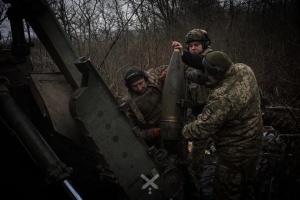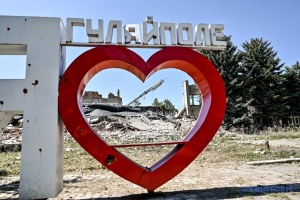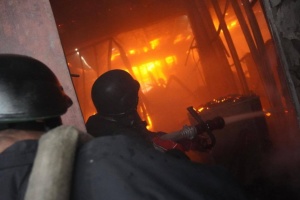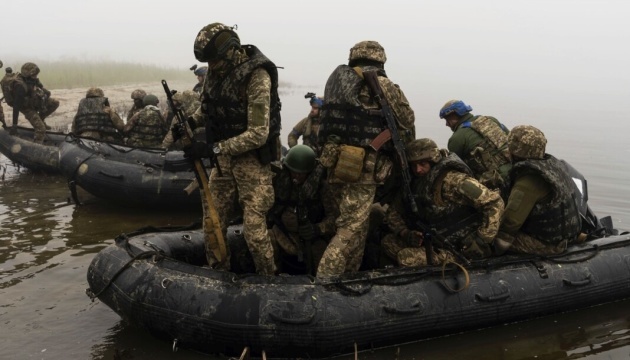
Left Bank Kherson Region: What to Expect from AFU Bridgehead Across Dnipro
Ukrainian footholds on the left bank of the Kherson region have finally ceased to be Polischynel's secret. Since mid-November, the General Staff of the Armed Forces of Ukraine has officially confirmed this information, emphasizing that "sabotage, raiding and reconnaissance activities are being conducted on this section of the southern front, the Defense Forces are tracking the logistics routes for the supply of ammunition and food to the Russians, as well as searching for and destroying their personnel and equipment." The enemy, according to the Ukrainian side, is suffering heavy losses.
According to Natalia Humeniuk, a spokesperson for the "South" military command, our military pushed the occupiers back 3-8 km from the Dnipro. Krynky, Poyma, Pishchanivka, Pidstepne, Oleshky, Nova Kakhovka, Kozachi Lageri are mentioned more and more often. The situation there is very difficult, heavy fighting continues. However, we see some prospects.
How is the situation on the left bank of the Dnipro River developing and how does it affect the situation on other fronts of this war?
The situation on the left bank of the Kherson region can change unpredictably, but so far the Russians cannot restrain the expansion of our bridgeheads
In a commentary to Ukrinform, military observer of the Information Resistance group Oleksandr Kovalenko said that the formation of the Ukrainian Defense Forces' bridgeheads on the left bank of the Dnipro River in Kherson region stumped the Russian command at a time when it did not even realize it. And it all started on October 10, when the lamp-bearers [as the expert calls the occupiers] received an order from their "supreme" to hand him Avdiivka on a silver platter.
"According to the original plan, as part of the offensive on October 10, two echelons of Russian occupation troops were to surround Avdiivka, thereby creating optimal conditions for the occupation of the city by the New Year, giving Putin a "victory" that he could feed to his information fast food consumers. The plan failed miserably," the analyst said.
As a result, Kovalenko noted, Avdiivka began to draw resources from other frontline areas, primarily from Luhansk, from the Center military group. In fact, the most capable part of this group of troops has now been redeployed to Avdiivka, including the almost complete 2nd Combined Arms Army, the 55th Separate Motorized Rifle Brigade of the 41st Combined Arms Army, and the 239th Tank Regiment of the 90th Tank Division. However, this was not enough for the Russian occupation forces to resolve the issue of encircling Avdiivka, the expert says.
"This is not surprising, because I have repeatedly pointed out that you can be the most combat-ready brigade, but this does not mean you are effective, because you are the most combat-ready compared to others. In the absence of full staffing in the Russian military, a regiment can perhaps be compared to a battalion in terms of its combat capability. Although, why "perhaps" - it is true, - says Mr. Kovalenko. - In addition, the nervousness of the enemy command in the Avdiivka area forced them to use inferior units and formations, and to throw individual units into the battle. All of this has led to the fact that the tasks set by Putin near Avdiivka will not be accomplished by the new year. And the only way to speed up this process is to provide additional resources to the area of operation. Simply put, we need to keep pushing with numbers. But where to get the resources?"
According to the expert, the "Center" group of troops is exhausted and will even be partially reinforced by units of the "West" group of troops. "So, maybe the 'South'? But in the south, the occupiers are also doing badly.
"The Armed Forces of Ukraine are crushing the left bank, continuing to expand their footholds. The road of the first line from Oleshky to Nova Kakhovka is cut in several places, and the specter of inevitable physical control hangs over the T2206 road. The command of the Dnipro Motorized Brigade hastily formed three tactical groups to block the Ukrainian Defense Forces in the area of Kozachy Lager and Krynky, while the 70th Motorized Infantry Division and the 7th Air Assault Division were in "standby" mode. I would like to remind you that the 7th Air Assault Division was returned from Zaporizhzhia region to strengthen the Dnipro group of troops, although before that it was supposed to strengthen the Vostok group of troops," the observer of the Information Resistance group notes. In his opinion, "it will be difficult to take someone directly from Zaporizhzhia region, because then the restraining potential of the occupiers in the wedge that the Armed Forces of Ukraine drove into the second line of defense will be weakened."
There is an interesting twist. To try to take Avdiivka before the new year, the Russians need more resources. They seem to have a lot of resources to draw from, with more than 400,000 occupants in the war zone. But the quality is not good. And where it is taken from, there is a problem of weakening the area, which also needs to be compensated by someone.
"A resource impasse? And it cannot be solved without mobilization? And until the "elections" are held in Russia, the topic of mobilization is taboo. This is why we have a phenomenon when the pressure of Ukrainian forces on the left bank of the Kherson region and the desperate desire of the occupiers to take Avdiivka create an unpredictable tension in the Russian troops, which will cause something to crack somewhere," Oleksandr Kovalenko is encouraged.
So, as you can see, the situation on the left bank of the Dnipro River has a significant impact on the events in the combat zone. But there is an important "but".
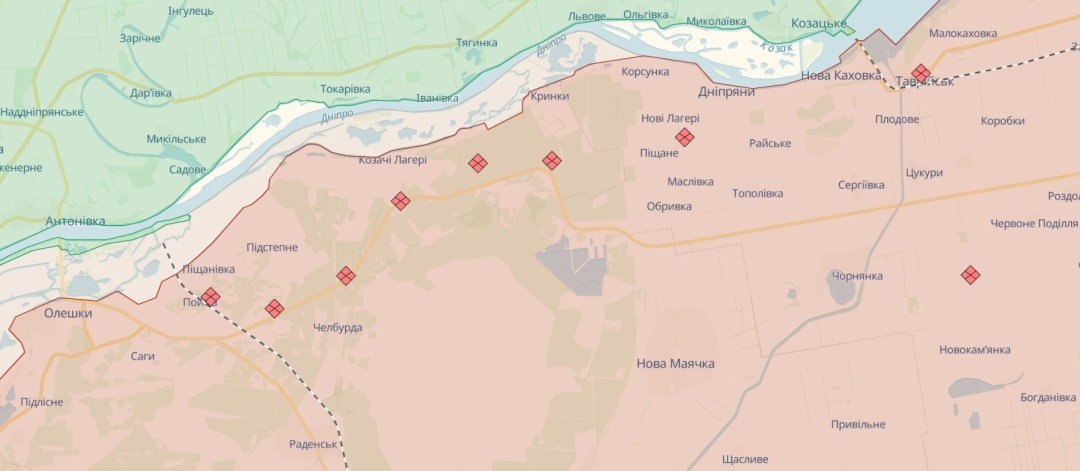
"In the left-bank Kherson region, Ukrainian forces are indeed making some progress, this is a fact. However, it is difficult to conduct any serious operations there, at least for now. The Russians are outnumbered on the left bank, and they have much more capabilities. We are in the minority."
The Ukrainian Defense Forces on the left bank are mainly infantry units with limited functionality without the support of a mechanized component.
"Most of the support that is provided is artillery from the right bank, as well as drones. Everything is really working effectively, but it is not enough. The situation can change unpredictably. However, so far, the Russians have not been able to restrain the expansion of our footholds. Moreover, we have already cut the road of the first frontier from Oleshky to Nova Kakhovka. This is a road that goes through such settlements as Pishchanivka, Kozachi Lageri, Krynky, Korsunka and on to Nova Kakhovka. Nowadays, Russians mostly use the T2206 highway, the same one that turns into the M-14 and goes from Oleshky to Melitopol. But between Kozachy Lahery and Krynky, especially near Krynky, we have already entered the forest, and the T2206 road itself is less than three kilometers away."
Cutting this highway will significantly worsen the enemy's situation.
"However, there will not be any large-scale breakthrough to Crimea, as I often hear from some colleagues, at least not yet. What is happening now on the left bank should be assessed in terms of creating a security buffer that will be expanded in the future. The security buffer will not only protect the right bank from Russian terrorist attacks, but will also allow us to build logistics from the right to the left bank more efficiently, and will allow us to create conditions for larger-scale offensives in the future. But it is too early to talk about this particular phase. Our goal is to push the enemy as far away from the right bank as possible. The further the Russian artillery is from Kherson, the better," emphasized Oleksandr Kovalenko.
Clearly, the actions of our troops on the left bank make the enemy nervous and rush their reserves between several bridgeheads and areas
Our military continue operations on the left bank of the Dnipro River in Kherson region, operating from three "base" footholds in the Krynky area, as well as near the Antonivskyi road bridge and the small railway bridge, six kilometers east of the Antonivskyi bridge, says Pavlo Lakiychuk, head of military programs at the Center for Global Studies "Strategy XXI". The Armed Forces of Ukraine are not just holding the bridgeheads, but are conducting maneuverable defense, moving to offensive actions.
"Preparations for the transition to the left bank, "probing" the enemy's defense of the RDG lasted for quite a long time, which obviously misled the Russians to some extent about the plans of our command - the appearance of Ukrainian bridgeheads on the left bank of the Dnipro was somewhat unexpected for them. This resulted in a shortage of reserves, most of which were redeployed to the Zaporizhzhia direction. That is why the command of the "Dnipro" group of troops is forced to use only what is "at hand" - part of the forces of the 7th Air Assault Division, marines from the "thinned" Sevastopol 810th Separate Marine Brigade and the 177th Separate Marine Regiment from the Caspian Sea, and other "BARS" and "Z-Stormers", - the military expert lists.
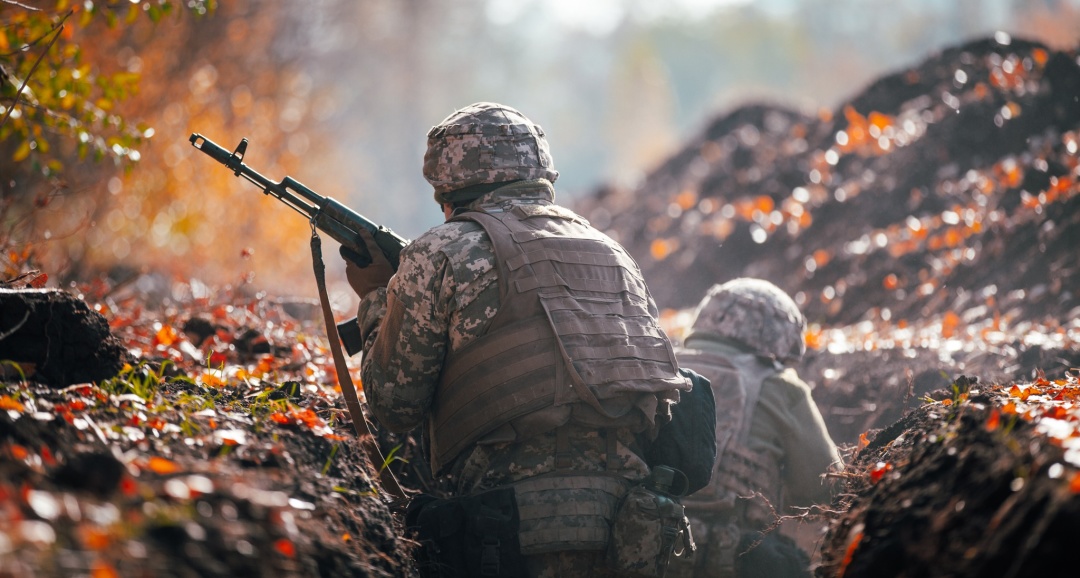
In recent days, despite significant losses in personnel and equipment, the Russians have managed to narrow the Armed Forces’ of Ukraine foothold near the village of Krynky with flanking attacks.
"The road junction in this direction is important: To "cut" it means to deprive the enemy of rocket logistics in the Dnipro region. Thus, Ukrainian troops have achieved tactical success in the direction of the E58 Oleshky-Kamyanka highway, "hovering" over Russian positions near the E58-E97 intersection south of the Poima-Pishchanivka-Pidstepne line. According to some observers, the advanced units of the Ukrainian Armed Forces continue to control the territory north of Pidstepne and a section of the coastal road, although the enemy is constantly attacking from the village," emphasizes Mr. Lakiychuk.
Something "interesting" is also happening west of Oleshky...
"The advantage of our defense forces on the left bank of the Dnipro is that in the coastal zone we can cover them with artillery fire from the right bank, the weakness is the difficulty of forcing the river with "heavy armor". The weather is also making its own adjustments: in low clouds, enemy aircraft have fewer opportunities to attack our forward positions, but our drones are flying worse and less frequently. It's not easy on the ground either - it's still a floodplain, a semi-swampy area," the expert states.
It is difficult to predict whether our offensive across the Dnipro will end in operational success or tactical achievements.
"Definitely, the actions of our troops on the left bank make the enemy nervous, rushing reserves between several bridgeheads and areas - concentrating operational reserves in the face of the fire initiative of Ukrainian artillery in the operational and tactical zone becomes an extremely difficult task for the enemy," our interlocutor added.
Subsequently, depending on the success of the Armed Forces of Ukraine on the Left Bank, the enemy may face a dilemma: whether to continue to focus on maintaining defense in the Zaporizhzhia sector or to somehow restrain the offensive in the Kherson region.
"A kind of "fork for Teplynskyi" [referring to Colonel General Mykhailo Teplynskyi, who is responsible for the occupied areas of Kherson region, including the eastern bank of the Dnipro River] Zugzwang?" - Pavlo Lakiychuk asks.
We will win in any development of the situation in the left-bank Kherson region
Roman Svitan, a reserve colonel in the Armed Forces of Ukraine, also shared his vision with Ukrinform, according to which the bridgehead on the left bank of the Kherson region has reached the tactical level. The defense forces are trying to expand it to the level of "operational". To do this, it must be at least 15 kilometers deep.
"We are now in the middle of this path. We have already advanced up to 8 km from the shore. But the operational bridgehead should be at least 15 kilometers to rebuild engineering structures, if a decision is made, to transfer heavy equipment, air defense systems, artillery to the left bank. These should be pontoon crossings, landing stages for barges. This is a process that has not yet begun, no decision has been made. So now we are talking about tactical, small bridgeheads," explains the military expert.
According to him, the further course of events, the decision of the command to cross the Dnipro and expand the bridgehead to the operational level will depend on a concrete understanding of our capabilities - the number of forces and means, as well as weapons to be provided by our partners.
"Here we depend on our partners. We cannot force the Dnipro without equipment and ammunition and hold on there. The Russians will immediately throw us into the river," emphasizes Mr. Svitan.
"However, we will still win in any scenario. There are three possible outcomes.
The first one is if the Russians react now and start transferring forces and means from, say, Avdiivka, Robotyne or Kupiansk to the Kherson direction to ensure the defense of the left bank.
"And this will be a win and the realization of the plans of General Zaluzhnyi and the General Staff of Ukraine. That is, we will stretch the Russian forces. We will eliminate the problem of Avdiivka, Robotyne and Kupyansk, and tie up the Russians in the Kherson sector. We are already winning, even if nothing else happens," emphasizes Mr. Svitan.
Another possibility is that the Russians will not withdraw their units from the front to try to eliminate our bridgehead:
"Given the small number of tactical footholds and the fact that the Armed Forces of Ukraine are not yet ready for serious actions on the left bank, the Russians will not rush to make a decision to seriously deploy additional forces here. Nevertheless, we will continue our work on expanding the bridgehead to an operational level, on pushing the enemy further away so that the front line moves away from Kherson," the military expert added.
"Even just expanding the sanitary zone created by our troops on the left bank will make life easier for Kherson residents who suffer greatly from enemy artillery shelling.
And the third scenario...
"If the Russians don't react to this either - maybe they just don't have anything to say - then the road to Armiansk in Crimea will be open to us. This is what we have been talking about for at least six months," the expert emphasized.
As of now, Roman Svitan emphasizes, it is not clear that the enemy is preparing to start transferring troops from the eastern front, in particular, from near Avdiivka, to the southern front.
"The Russians are taking certain actions based on our actions. It's like a tango, a dance for two, where a lot depends on the partner. At the moment, we can talk more about a kind of rotational mode, that is, without any serious movements of brigades, corps, armies - not the number of troops that would be beneficial for us if the Russians withdrew, say, from the eastern front..." says the reserve colonel of the Armed Forces of Ukraine. - "Although, judging by the cries of some of their 'military leaders', they are, in principle, preparing for such steps."
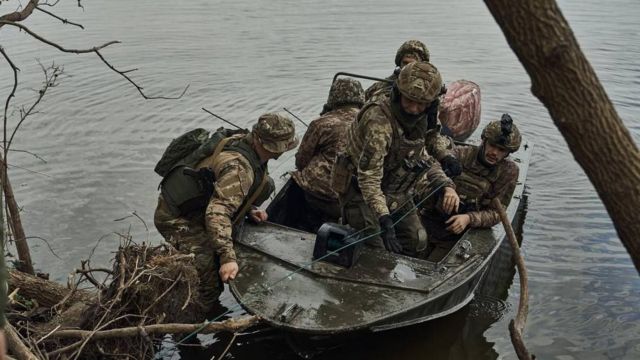
Speaking of crying out. According to the Institute for the Study of War, Russian military bloggers are constantly complaining that their troops are unable to suppress Ukrainian operations on the left bank of the Dnipro: "On November 21, a Russian military blogger claimed that Ukrainian troops had destroyed an entire Russian assault group near Krynky. Earlier, on November 17, a Russian insider source said that the Ukrainian strike killed 76 Russians in the 1st Battalion of the 35th Separate Mechanized Brigade (41st Combined Arms Army of the Central Military District), who were trying to conduct a "distraction maneuver" in the Skadovsk district."
In general, the enemy suffers huge losses in personnel on all fronts. Often, the daily losses of the occupiers exceed a thousand.
"This indicates that the enemy's balance is shifting to the negative. As you know, the Russians mobilize about 20,000 people a month. But if we deduct up to a thousand or even more every day, it means that we are losing 30 thousand a month. A deficit of 10,000 every month. This is a good figure, and we need to do our best to keep it at this level - a thousand or more," assures Mr. Svitan.
In general, the situation on other fronts of the Great War has not changed much since the publication of our last article (for more details, follow the link). In most areas, the Armed Forces of Ukraine are preparing to take up active defense, but they will not stop moving towards Bakhmut, where there is a positive dynamic for us.
"The Armed Forces of Ukraine are in a very good position there - on the dominant heights. In the area of Klishchiyivka, on the eastern side of the railroad that runs from Horlivka to Bakhmut, there are several footholds that our troops are expanding. The main task is to cross the highway - we already have it under fire control - and then reach the Bakhmutka River. When we have a solid foothold on the left bank of the Bakhmutka, we will be able to move towards Bakhmut, entering the city center from the south and cutting off the Russians. This is a strategic task that we will fulfill in the fall and winter," the military expert believes.
As for the Tokmak direction... The development of the situation there will directly depend on the supply of weapons and ammunition.
"In Zaporizhzhia region, we have left one strategic direction active. In the area of Robotyne, we are expanding the bridgehead and strengthening our flanks to move south," comments Roman Svitan. "But our prospects in this area will directly depend on the supply of weapons, including new types of weapons. If we receive several thousand M-26 shells with cassette warheads for HIMARS, we will be able to move towards Tokmak and cross the railroad..."
If they don't give us the shells (or give us insufficient numbers), we will still move there, but slowly, at the level of 100-200 meters per day.
Myroslav Liskovych, Kyiv
First photo: AP Photo/Alex Babenko


